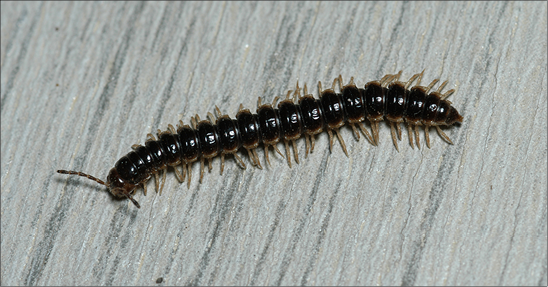Greenhouse Millipede | Vol 3, No. 14

Oxidus gracilis
Order: Diplopoda
Family: Polydesmida
People who are frequently plagued by millipedes will immediately notice something unusual about this picture. There’s only one millipede! During periods of extended wet warm weather, homes and other buildings located near suitable breeding sites may experience hundreds or thousands of these hard-bodied, ¾ inch long arthropods around the premises. They don’t bite and they don’t damage plants, but large numbers of millipedes dying on the carport and crawling into the house can quickly become a seriously annoying nuisance.
Greenhouse millipedes, a.k.a. garden millipedes, are not native to the US, but they are now common throughout the country. They came from Asia, but they are so easily transported in potted plants, mulch, and similar items that they spread quickly once they got here, despite their lack of wings. These little millipedes feed on decaying plant material, such as leaf litter, mulch, and grass thatch in lawns. Despite their hard exoskeletons, millipedes are highly susceptible to desiccation, and it is only during wet rainy periods that they can leave their normal habitats and go wandering about, and this is when the heavy home invasions occur. Once they get inside a building or on the carport they usually die quickly due to desiccation, and spraying these areas with insecticides does little to reduce their numbers. The problem is that, even though you kill the ones that are there, more millipedes just keep wandering up from their breeding sites.
Control: Insecticides are not especially useful for controlling millipedes and preventing indoor invasions. Good exclusion practices are the best first line of defense. This means sealing cracks and crevices through which millipedes and other pests might enter and installing tight-fitting weather seals and thresholds around doors and windows. A broom and dust pan, and/or a wet/dry vacuum or leaf blower is often the best “treatment” for millipedes that accumulate on carports and patios. Even if you kill them with insecticides in these locations, you still have to get rid of all those crunchy little bodies. Exterior building perimeter sprays with insecticides such as bifenthrin, cyfluthrin, or carbaryl can sometimes help reduce the number of millipedes that make it all the way inside the building, but don’t expect complete control during periods of heavy millipede movement. Dry weather is the best cure for millipede problems.
See page 12 of Extension Publication 2331, Control Insect Pests In and Around the Home Lawn for more information - https://extension.msstate.edu/sites/default/files/publications/publications/p2331.pdf.
Blake Layton, Extension Entomology Specialist, Mississippi State University Extension Service.
The information given here is for educational purposes only. Always read and follow current label directions. Specific commercial products are mentioned as examples only and reference to specific products or trade names is made with the understanding that no discrimination is intended to other products that may also be suitable and appropriately labeled.
Sign up to receive Bug's Eye View.

